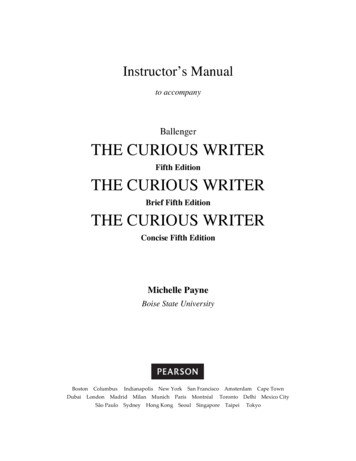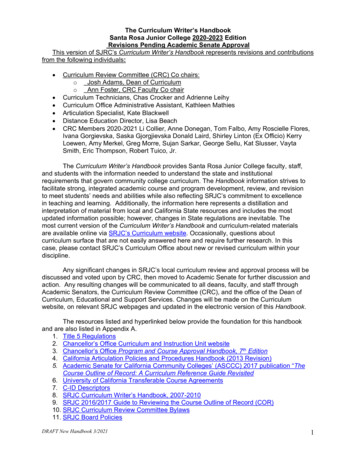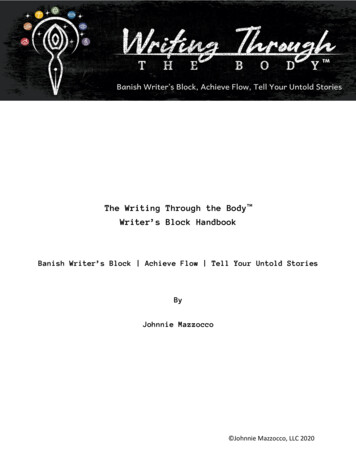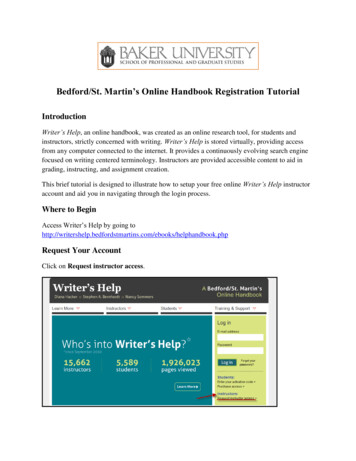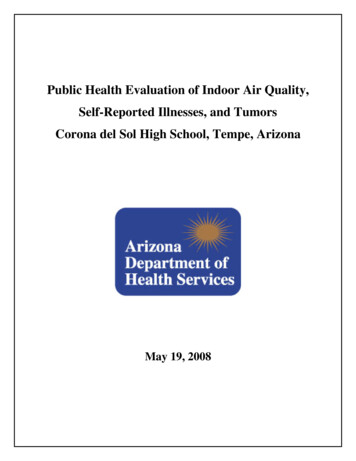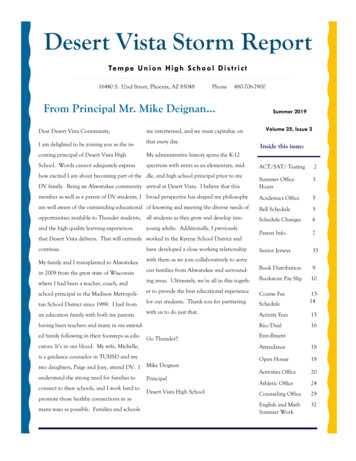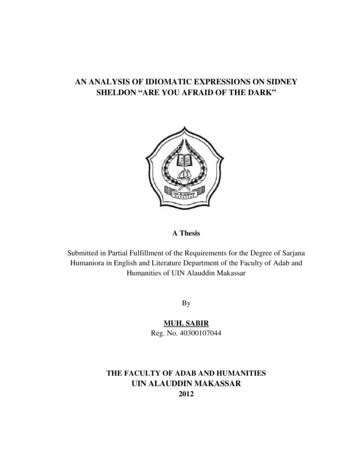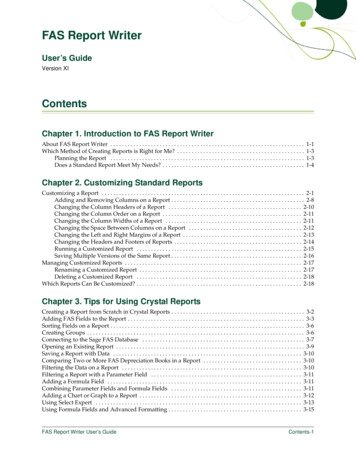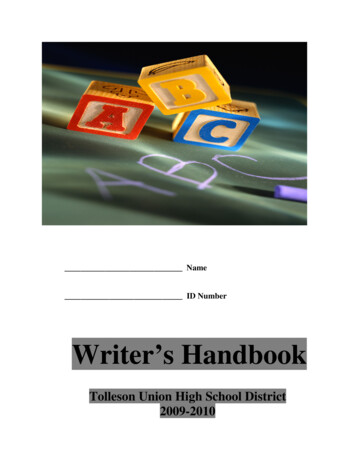
Transcription
NameID NumberWriter’s HandbookTolleson Union High School District2009-2010
IntroductionThis manual is a handy, quick, yet comprehensive student guide to writing. It providesguidelines on formatting and documentation for essays and research papers as well as basicpunctuation and usage rules for common errors. As a student in the Tolleson Union High SchoolDistrict, you are expected to refer to this manual in class and/or at home when writing for anysubject.The state of Arizona has adopted the Six Trait Writing Model. This model delineates the writingcharacteristics that students will be expected to master in class and in order to pass the AIMStest. Following this introduction, you will find an overview of the Six Traits and of the FiveParagraph Essay Format.In addition to the Six Trait Writing Model and the Five Paragraph Essay Format, the TollesonUnion High School District has adopted the Modern Language Association (MLA) format forwritten work. This reference manual provides guidelines to be used when writing essays,reports, and/or research papers that utilize resources (such as other people, books, magazines,newspapers, Internet, etc.). There are several different styles of documentation (APA/AmericanPsychological Association, CBE/Council of Biology, and The Chicago Manual of Style);however, while attending school in the Tolleson District, MLA is the standard. If you continueon to college, you should always ask your professor which style he/she prefers. Yourteacher/professor has the final say, and you should always follow his/her guidelines.Academic work requires documentation for several reasons:1. Documenting sources allows readers to locate the publication information on sourcematerial. This is of value to researchers who may want to locate your sources for theirown research. Teachers use this information to check on the accuracy of your work.2. The proper use of documentation shows the credibility of the writer.3. Most importantly for a student, the use of MLA documentation protects you fromaccusations of plagiarism—the purposeful or accidental use of source material by otherwriters without giving appropriate credit.Please note that all documentation styles change over time. The material provided here was themost accurate available at the time of preparation and was taken from the MLA Handbook forWriters of Research Papers (7th edition) and The OWL at Purdue University. As a student, youare responsible for continually checking the timeliness of your resources. While in high school,your teacher will keep you updated; in college, check on line or at the bookstore for newereditions of the handbook.Remember, this reference manual is a guide. No one expects you to memorize the materialprovided; teachers do, however, expect you to check this book frequently and follow theseguidelines closely when writing for class.
The Six Trait Analytical Model for Writing AssessmentIdeas & ContentIdeas and content are the heart of the message, what the piece says,the main idea or thesis and the details that enrich, support and develop thatidea.OrganizationOrganization is the structure, the order in which the ideas are presented,the logical and sometimes intriguing pattern of the ideas in a piece of writing.ConventionsConventions are the mechanics of the piece—spelling, paragraphing, grammar andusage, punctuation, capitalization.Sentence FluencySentence fluency is the rhythm and flow of the language, the sound of wordpatterns, the way in which the writing plays to the ear. Sentence varietyand length.Word ChoiceWord choice is the use of rich, colorful, precise, specific language that moves andenlightens the reader and is appropriate for the intended audience and purpose.VoiceVoice is the wit, the magic, the feeling, the involvement and conviction of the individualwriter coming out in the writing. Voice must be appropriate for the topic, purpose andaudience.This is a revision of the 6 1 model from Northwest Regional Educational Laboratory.
CONVENTIONS654The writing demonstrates exceptionallystrong control of standard writingconventions (e.g., punctuation, spelling,capitalization, paragraph breaks, grammarand usage) and uses them effectively toenhance communication. Errors are so fewand so minor that the reader can easilyskim right over them unless specificallysearching for them. The writing ischaracterized by strong control of conventions;manipulation of conventions may occurfor stylistic effect. strong, effective use of punctuation thatguides the reader through the text. correct spelling, even of more difficultwords. paragraph breaks that reinforce theorganizational structure. correct grammar and usage thatcontribute to clarity and style. skill in using a wide range ofconventions in a sufficiently long andcomplex piece. little or no need for editing.The writing demonstrates strong control ofstandard writing conventions (e.g.,punctuation, spelling, capitalization,paragraph breaks, grammar and usage) anduses them effectively to enhancecommunication. Errors are so few and sominor that they do not impede readability.The writing is characterized by strong control of conventions. effective use of punctuation that guides thereader through the text. correct spelling, even of more difficultwords. paragraph breaks that reinforce theorganizational structure. correct capitalization; errors, if any, areminor. correct grammar and usage that contributeto clarity and style. skill in using a wide range of conventions ina sufficiently long and complex piece. little need for editing.The writing demonstrates control ofstandard writing conventions (e.g.,punctuation, spelling, capitalization,paragraph breaks, grammar and usage).Minor errors, while perhaps noticeable,do not impede readability. The writingis characterized by control over conventions used,although a wide range is notdemonstrated. correct end-of-sentence punctuation,internal punctuation may sometimes beincorrect. spelling that is usually correct,especially on common words. basically sound paragraph breaks thatreinforce the organizational structure. correct capitalization; errors, if any,are minor. occasional lapses in correct grammarand usage; problems are not severeenough to distort meaning or confusethe reader. moderate need for editing.321The writing demonstrates limited controlof standard writing conventions (e.g.,punctuation, spelling, capitalization,paragraph breaks, grammar and usage).Errors begin to impede readability. Thewriting is characterized by some control over basic conventions; thetext may be too simple to reveal mastery. end-of-sentence punctuation that isusually correct; however, internalpunctuation contains frequent errors. spelling errors that distract the reader;misspelling of common words occurs. paragraphs that sometimes run togetheror begin at ineffective places. capitalization errors. errors in grammar and usage that do notblock meaning but do distract the reader. significant need for editing.The writing demonstrates little control ofstandard writing conventions. Frequent,significant errors impede readability. Thewriting is characterized by little control over basic conventions. many end-of-sentence punctuation errors;internal punctuation contains frequent errors. spelling errors that frequently distract thereader; misspelling of common words oftenoccurs. paragraphs that often run together or beginin ineffective places. capitalization that is inconsistent or oftenincorrect. errors in grammar and usage that interferewith readability and meaning. substantial need for editing.Numerous errors in usage, spelling,capitalization, and punctuationrepeatedly distract the reader and makethe text difficult to read. In fact, theseverity and frequency of errors are sooverwhelming that the reader finds itdifficult to focus on the message andmust reread for meaning. The writing ischaracterized by very limited skill in using conventions. basic punctuation (including end-ofsentence punctuation) that tends to beomitted, haphazard, or incorrect. frequent spelling errors thatsignificantly impair readability. paragraph breaks that may be highlyirregular or so frequent (every sentence)that they bear no relation to theorganization of the text. capitalization that appears to berandom. a need for extensive editing. Oregon Department of Education. All rights reserved.
IDEAS & CONTENT654The writing is exceptionally clear,focused and interesting. It holdsthe reader’s attention throughout.Main ideas stand out and aredeveloped by strong support andrich details suitable to audienceand purpose. The writing ischaracterized by clarity, focus, and control. main idea(s) that stand out. supporting, relevant, carefullyselected details; when appropriate,use of resources provides strong,accurate, credible support a thorough, balanced, in-depthexplanation/ exploration of thetopic; the writing makesconnections and shares insights. content and selected details thatare well suited to audience andpurpose.The writing is clear, focused andinteresting. It holds the reader’sattention. Main ideas stand out andare developed by supporting detailssuitable to audience and purpose. Thewriting is characterized by clarity, focus, and control. main idea(s) that stand out. supporting, relevant, carefullyselected details; when appropriate, useof resources provides strong, accurate,credible support. a thorough, balancedexplanation/exploration of the topic;the writing makes connections andshares insights. content and selected details that arewell-suited to audience and purpose.The writing is clear and focused. Thereader can easily understand the mainideas. Support is present, although itmay be limited or rather general. Thewriting is characterized by an easily identifiable purpose. clear main idea(s) supporting details that are relevant,but may be overly general or limitedin places; when appropriate,resources are used to provideaccurate support. a topic that is explored/explained,although developmental details mayoccasionally be out of balance withthe main idea(s); some connectionsand insights may be present. content and selected details that arerelevant, but perhaps not consistentlywell chosen for audience andpurpose.321The reader can understand themain ideas, although they may beoverly broad or simplistic, and theresults may not be effective.Supporting detail is often limited,insubstantial, overly general, oroccasionally slightly off-topic.The writing is characterized by an easily identifiable purposeand main idea(s). predictable or overly-obviousmain ideas or plot; conclusions ormain points seem to echoobservations heard elsewhere. support that is attempted; butdevelopmental details that areoften limited in scope, uneven,somewhat off-topic, predictable,or overly general. details that may not be wellgrounded in credible resources;they may be based on clichés,stereotypes or questionablesources of information. difficulties when moving fromgeneral observations to specifics.Main ideas and purpose are somewhatunclear or development is attemptedbut minimal. The writing ischaracterized by a purpose and main idea(s) that mayrequire extensive inferences by thereader. minimal development; insufficientdetails. irrelevant details that clutter the text. extensive repetition of detail.The writing lacks a central idea orpurpose. The writing is characterizedby ideas that are extremely limited orsimply unclear. attempts at development that areminimal or non-existent; the paper istoo short to demonstrate thedevelopment of an idea.
ORGANIZATION654The organization enhances the centralidea(s) and its development. Theorder and structure are compellingand move the reader through the texteasily. The writing is characterizedby effective, perhaps creative,sequencing; the organizationalstructure fits the topic, and thewriting is easy to follow. a strong, inviting beginning thatdraws the reader in and a strongsatisfying sense of resolution orclosure. smooth, effective transitions amongall elements (sentences, paragraphs,and ideas). details that fit where placed.The organization enhances the centralidea(s) and its development. The order andstructure are strong and move the readerthrough the text. The writing ischaracterized by. effective sequencing; the organizationalstructure fits the topic, and the writing iseasy to follow. an inviting beginning that draws thereader in and a satisfying sense ofresolution or closure. smooth, effective transitions among allelements (sentences, paragraphs, andideas). details that fit where placed.Organization is clear and coherent. Orderand structure are present, but may seemformulaic. The writing is characterized by clear sequencing. an organization that may be predictable. a recognizable, developed beginningthat may not be particularly inviting; adeveloped conclusion that may lacksubtlety. a body that is easy to follow with detailsthat fit where placed. transitions that may be stilted orformulaic. organization which helps the reader,despite some weaknesses.321An attempt has been made toorganize the writing; however, theoverall structure is inconsistent orskeletal. The writing is characterizedby attempts at sequencing, but theorder or the relationship among ideasmay occasionally be unclear. a beginning and an ending which,although present, are eitherundeveloped or too obvious (e.g.“My topic is.”, “These are all thereasons that ”) transitions that sometimes work.The same few transitional devices(e.g., coordinating conjunctions,numbering, etc.) may be overused. a structure that is skeletal or toorigid. placement of details that may notalways be effective. organization which lapses in someplaces, but helps the reader in others.The writing lacks a clear organizationalstructure. An occasional organizationaldevice is discernible; however, the writingis either difficult to follow and the readerhas to reread substantial portions, or thepiece is simply too short to demonstrateorganizational skills. The writing ischaracterized by some attempts at sequencing, but theorder or the relationship among ideas isfrequently unclear. a missing or extremely undevelopedbeginning, body, and/or ending. a lack of transitions, or when present,ineffective or overused. a lack of an effective organizationalstructure. details that seem to be randomly placed,leaving the reader frequently confused.The writing lacks coherence; organizationseems haphazard and disjointed. Evenafter rereading, the reader remainsconfused. The writing is characterized by a lack of effective sequencing. a failure to provide an identifiablebeginning, body and/or ending. a lack of transitions. pacing that is consistently awkward; thereader feels either mired down in trivia orrushed along too rapidly. a lack of organization which ultimatelyobscures or distorts the main point.
SENTENCE FLUENCY654The writing has an effective flowand rhythm. Sentences show a highdegree of craftsmanship, withconsistently strong and variedstructure that makes expressive oralreading easy and enjoyable. Thewriting is characterized by a natural, fluent sound; it glidesalong with one sentence flowingeffortlessly into the next. extensive variation in sentencestructure, length, and beginningsthat add interest to the text. sentence structure that enhancesmeaning by drawing attention to keyideas or reinforcing relationshipsamong ideas. varied sentence patterns that createan effective combination of powerand grace. strong control over sentencestructure; fragments, if used at all,work well. stylistic control; dialogue, if used,sounds natural.The writing has an easy flow andrhythm. Sentences are carefully crafted,with strong and varied structure thatmakes expressive oral reading easy andenjoyable. The writing is characterizedby a natural, fluent sound; it glides alongwith one sentence flowing into the next. variation in sentence structure, length,and beginnings that add interest to thetext. sentence structure that enhancesmeaning. control over sentence structure;fragments, if used at all, work well. stylistic control; dialogue, if usedsounds natural.The writing flows; however,connections between phrases orsentences may be less than fluid.Sentence patterns are somewhat varied,contributing to ease in oral reading. Thewriting is characterized by a natural sound; the reader can moveeasily through the piece, although it maylack a certain rhythm and grace. some repeated patterns of sentencestructure, length, and beginnings thatmay detract somewhat from overallimpact. strong control over simple sentencestructures, but variable control overmore complex sentences; fragments, ifpresent, are usually effective. occasional lapses in stylistic control;dialogue, if used, sounds natural for themost part, but may at times sound stiltedor unnatural.321The writing tends to be mechanicalrather than fluid. Occasionalawkward constructions may forcethe reader to slow down or reread.The writing is characterized by some passages that invite fluid oralreading; however, others do not. some variety in sentencesstructure, length, and beginnings,although the writer falls intorepetitive sentence patterns. good control over simple sentencestructures, but little control overmore complex sentences; fragments,if present, may not be effective. sentences which, althoughfunctional, lack energy. lapses in stylistic control; dialogue,if used, may sound stilted orunnatural.The writing tends to be either choppy orrambling. Awkward constructions oftenforce the reader to slow down or reread.The writing is characterized by significant portions of the text that aredifficult to follow or read aloud. sentence patterns that are monotonous(e.g., subject-verb or subject-verbobject). a significant number of awkward,choppy, or rambling constructions.The writing is difficult to follow or toread aloud. Sentences tend to beincomplete, rambling, or very awkward.The writing is characterized by text that does not invite—and may noteven permit—smooth oral reading. confusing word order that is oftenjarring and irregular. sentence structure that frequentlyobscures meaning. sentences that are disjointed,confusing, or rambling.
VOICE654The writer has chosen a voice appropriate forthe topic, purpose and audience. The writerseems deeply committed to the topic, andthere is an exceptional sense of “writing to beread.” The writing is expressive, engaging, orsincere. The writing is characterized byan effective level of closeness to or distancefrom the audience (e.g., a narrative shouldhave a strong personal voice, while anexpository piece may require extensive use ofoutside resources and a more academic voice;nevertheless, both should be engaging, lively,or interesting. Technical writing may requiregreater distance.).an exceptionally strong sense of audience; thewriter seems to be aware of the reader and ofhow to communicate the message mosteffectively. The reader may discern the writerbehind the words and feel a sense ofinteraction.a sense that the topic has come to life; whenappropriate, the writing may show originality,liveliness, honesty, conviction, excitement,humor, or suspense.The writer has chosen a voice appropriatefor the topic, purpose, and audience. Thewriter seems committed to the topic, andthere is a sense of “writing to be read.”The writing is expressive, engaging orsincere. The writing is characterized by an appropriate level of closeness to ordistance from the audience (e.g., anarrative should have a strong personalvoice while an expository piece mayrequire extensive use of outside resourcesand a more academic voice; nevertheless,both should be engaging, lively orinteresting. Technical writing may requiregreater distance.). a strong sense of audience; the writerseems to be aware of the reader and ofhow to communicate the message mosteffectively. The reader may discern thewriter behind the words and feel a sense ofinteraction. a sense that the topic has come to life;when appropriate, the writing may showoriginality, liveliness, honesty, conviction,excitement, humor, or suspense.A voice is present. The writerdemonstrates commitment to the topic,and there may be a sense of “writing tobe read.” In places, the writing isexpressive, engaging, or sincere. Thewriting is characterized by a questionable or inconsistent level ofcloseness to or distance from theaudience. a sense of audience; the writer seems tobe aware of the reader but has notconsistently employed an appropriatevoice. The reader may glimpse the writerbehind the words and feel a sense ofinteraction in places. liveliness, sincerity, or humor whenappropriate; however, at times thewriting may be either inappropriatelycasual or personal, or inappropriatelyformal and stiff.321The writer’s commitment to the topic seemsinconsistent. A sense of the writer mayemerge at times; however, the voice is eitherinappropriately personal or inappropriatelyimpersonal. The writing is characterized bya limited sense of audience; the writer’sawareness of the reader is unclear.an occasional sense of the writer behind thewords; however, the voice may shift ordisappear a line or two later and the writingbecome somewhat mechanical.a limited ability to shift to a more objectivevoice when necessary.The writing provides little sense ofinvolvement or commitment. There is noevidence that the writer has chosen asuitable voice. The writing ischaracterized by little engagement of the writer; thewriting tends to be largely flat, lifeless,stiff, or mechanical. a voice that is likely to be overlyinformal and personal. a lack of audience awareness; there islittle sense of "writing to be read." little or no hint of the writer behind thewords. There is rarely a sense ofinteraction between reader and writer.The writing seems to lack a sense ofinvolvement or commitment. Thewriting is characterized by no engagement of the writer; thewriting is flat and lifeless. a lack of audience awareness; there isno sense of “writing to be read.” no hint of the writer behind the words.There is no sense of interaction betweenwriter and reader; the writing does notinvolve or engage the reader. Oregon Department of Education. All rights reserved.
WORD CHOICE654Words convey the intended message inan exceptionally interesting, precise,and natural way appropriate toaudience and purpose. The writeremploys a rich, broad range of words,which have been carefully chosen andthoughtfully placed for impact. Thewriting is characterized by accurate, strong, specific words;powerful words energize the writing. fresh, original expression; slang, ifused, seems purposeful and is effective. vocabulary that is striking and varied,but that is natural and not overdone. ordinary words used in an unusualway. words that evoke strong images;figurative language may be used.Words convey the intended message inan interesting, precise, and natural wayappropriate to audience and purpose.The writer employs a broad range ofwords which have been carefullychosen and thoughtfully placed forimpact. The writing is characterized by accurate, specific words; wordchoices energize the writing. fresh, vivid expression; slang, if used,seems purposeful and is effective. vocabulary that may be striking andvaried, but that is natural and notoverdone. ordinary words used in an unusualway. words that evoke clear images;figurative language may be used.Words effectively convey theintended message. The writer employsa variety of words that are functionaland appropriate to audience andpurpose. The writing is characterizedby words that work but do notparticularly energize the writing. expression that is functional;however, slang, if used, does not seempurposeful and is not particularlyeffective. attempts at colorful language thatmay occasionally seem overdone. occasional overuse of technicallanguage or jargon. rare experiments with language;however, the writing may have somefine moments and generally avoidsclichés.321Language is quite ordinary, lackinginterest, precision and variety, or maybe inappropriate to audience andpurpose in places. The writer does notemploy a variety of words, producing asort of “generic” paper filled withfamiliar words and phrases. The writingis characterized by words that work, but that rarelycapture the reader’s interest. expression that seems mundane andgeneral; slang, if used, does not seempurposeful and is not effective. attempts at colorful language thatseem overdone or forced. words that are accurate for the mostpart, although misused words mayoccasionally appear, technical languageor jargon may be overused orinappropriately used. reliance on clichés and overusedexpressions.Language is monotonous and/ormisused, detracting from the meaningand impact. The writing ischaracterized by words that are colorless, flat orimprecise. monotonous repetition oroverwhelming reliance on wornexpressions that repeatedly distractfrom the message. images that are fuzzy or absentaltogether.The writing shows an extremelylimited vocabulary or is so filled withmisuses of words that the meaning isobscured. Only the most general kindof message is communicated becauseof vague or imprecise language. Thewriting is characterized by general, vague words that fail tocommunicate. an extremely limited range of words. words that simply do not fit the text;they seem imprecise, inadequate, orjust plain wrong. Oregon Department of Education. All rights reserved.
Writer’s Reference ManualTolleson Union High School DistrictThe Writing ProcessWriting, like any other skill, takes practice; however, there is a process which makes writingeasier and, hopefully, better.Step 1—Prewriting:The first stage or step of the process is called prewriting. In this step, the writer explores ideas inorder to select a topic, determines a purpose and focus or point relating to that topic, identifiesthe audience and gathers information about the topic. Prewriting can take many forms, such as:BrainstormingMappingResearchingOutliningAsking questionsThe more attention a writer pays to prewriting, the less trouble he/she will have during thewriting or drafting stage.Step 2—Drafting:The drafting stage is when you put your ideas on paper and develop them. Since a topic andfocus were decided on in the prewriting stage and information was gathered, drafting becomessimply a matter of writing that information in a clear, interesting format.Step 3—Revising:Once the first draft is written, set it aside for awhile. When you return to your paper, you willneed to think about making it better, or revising it.First, revise for content by asking yourself: Does my writing have a clear thesis? Have I included adequate detail to make my point? Is there any unnecessary, unrelated or confusing information in my writing?If you are not satisfied with the answers to these questions, you have work to do. You may needto clarify your thesis, find more or stronger details to support your point, and/or deleteinappropriate or confusing ideas.Next, revise for structure by asking yourself: Is the writing clear? Is the flow of sentences and ideas smooth and logical? Do I have adequate transitional words, phrases or sentences to help the reader seethe relationships between ideas? Do I have adequate sentence variety to make the writing interesting? Is my word choice precise and appropriate for the purpose and audience?If you spot problems with any of these areas, this is the time to fix them.- 10 -
Writer’s Reference ManualTolleson Union High School DistrictStep 4—Editing (often called proofreading):At this point, your have your ideas presented in a clear, logical manner with adequate supportingdetails to make your reader understand your point. Now it’s time to look at conventions. Lookfor mistakes in spelling, punctuation, usage, capitalization, subject/verb agreement, and all thosedetails that can hurt your grade and irritate your reader by making your ideas hard to follow.You may want to do this several times. It is also a good idea to seek help from other people. Ifyou know you have problems with spelling, find someone who is good at it to help you.Step 5—Publishing:Now that the paper says what you want it to say and has no errors, it’s time to write or type thefinal draft. Be sure to follow MLA format for margins, headings, and other publishing rules.Congratulations, your paper is done! Put it aside at least over night. Then read it one last time tomake sure you didn’t leave out any words or make any typing errors. It’s a good idea to compareyour paper to the six trait rubric that teachers use in grading.- 11 -
Writer’s Reference ManualTolleson Union High School DistrictThe Five Paragraph EssayThe five paragraph essay format is a standard model for academic writing. It can be expandedfrom five paragraphs into 10, 20, 50 or more paragraphs, but the format remains the same. Inother words, the length of the paper is not the important point. The important thing is that, like astory, an essay or research paper has a beginning, a middle, and an end and says something worthreading. In the five paragraph essay model, the format looks like this:Introduction (or beginning)This introduces the reader to the topic of the paper in an appealing, interesting way.In a five paragraph essay, this is your first paragraph. It begins with an attention grabber whichmay be a relevant quotation, a question, an interesting anecdote, a surprising statement on thetopic, or anything relevant that will catch the reader’s interest. The introduction also providesbackground information to help the reader understand the topic and/or the importance of thetopic. The last sentence of the introductory paragraph is the thesis statement. This thesissentence is the blueprint for the essay. It gives the reader the topic, the opinion or point to bemade about the topic, and usually states the large po
Writer's Handbook Tolleson Union High School District 2009-2010 . Introduction This manual is a handy, quick, yet comprehensive student guide to writing. It provides . most accurate available at the time of preparation and was taken from the MLA Handbook for Writers of Research Papers (7th edition) and The OWL at Purdue University. As a .

